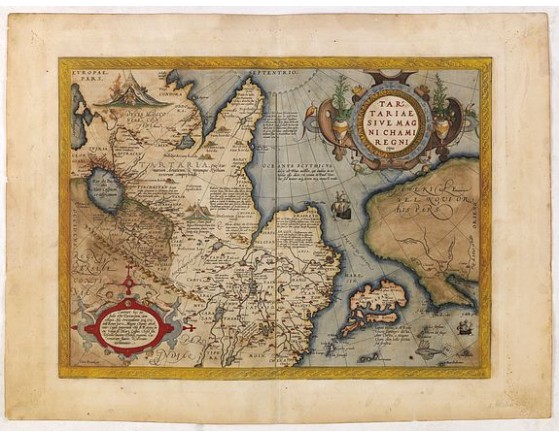ORTELIUS, A. - Tartariae sive Magni Chami Imperium.
 Click on image to zoom
Click on image to zoom

ORTELIUS, A. - Tartariae sive Magni Chami Imperium.
Published: Antwerp, c. 1590
Size: 382 x 500mm.
Color: In attractive strong original colours.
Condition: Paper very slightly age-toned. Dark impression, printed on heavy paper. Some light offsetting due to oxidation of ink and colours. With French text on verso.
Description
This is a very early depiction of the northern Pacific, with the first mapping of the Northwest Coast of America and probably the first map to name California 'C. California and show the name 'Sierra Nevada' along the West Coast.
Its main feature is the STRETTO DI ANIAN, which increased public awareness of the 1561 Giacomo Gastaldi theory of a strait between the continents of Asia and America.
At its southern entrance, an enlarged Japan dominates, below which a note states that a large amount of the information in Asia emanates from Marco Polo's writings.
The west coast of North America differs from his map of America in that the peninsula is broader, some different names appear, and others are lacking.
The map identifies China and Japan, but not Korea. The body of water between China and the Japanese archipelago is known as MARE CIN, which means the China Sea.
To the west is the Caspian Sea labeled "Mar de Bachu olin Mare Caspiam et Hyrcarum".
Modern-day Uzbekistan has its ancient name of SAMARC with the important trading town of "Samarchand magni Tamberquonda sedes" (Samarkand) in the center.
The map is richly annotated in Latin, including some of the lengthier quotes, which have been translated from Latin to English below:
The Nephalites are named Neptali after one of the 10 tribes with a Hebrew name, and after the Danites, who by way of punishment were called the Danes of the dark North, and they were on account of the claims of Rachel Balbah placed to the side, in the area of the Hudores or Iehudeores; in the year 476 they were victorious in their battle against Perosa. Others call them incorrectly Euthalites.
The Scythian Ocean, according to Plinius, has sweet water, and he also says it contains many islands, M. Paulus [Marco Polo] also says, but neither of the two tells about their number or location. Tabor or Tybur, center of the area of the Tartars, where once the Holy Books got lost, yet they are united under one king, who in 1540 first reached France and King Franciscus, and later, at the initiative of Charles the Fifth was burnt at the stake for his heresy, because he had secretly endeavored to convert Christian kings to the Jewish religion, about which he had spoken with Charles the Fifth.
One of the most famous travelers of the Silk Road was Marco Polo (1254 C.E. –1324 C.E.). Born into a family of wealthy merchants in Venice, Italy, Marco traveled with his father to China (then Cathay) when he was just 17 years of age. They traveled for over three years before arriving at Kublai Khan’s palace at Xanadu in 1275 C.E. Marco stayed on at Khan’s court and was sent on missions to parts of Asia never before visited by Europeans. Upon his return, Marco Polo wrote about his adventures, making him—and the routes he traveled—famous.
The ten tribes retreated and moved from the Tatar or Tartar area to Scythia. Since then, they are called Gauths or Gauthens, confirming God's highest glory, and here lies the splendid kingdom of Cathai. Turkestan. The area from which the 10 tribes as allies living on this side of the mountain range was called 900 years ago by the Persians to fight the armies of Ismael the Muslim.
The great Khan (which in the Tatar language means emperor) is the highest ruler of Asia. Argon. Once, there was a Christian kingdom in Asia known to Prester John, and D. Thomas founded it [this city] in this place so that it was in contact with the church of Rome and was subjected to Rome through Prester John of Africa.
This map contains the area of Tartaria, with the remaining part of East Asia to the Morning Ocean, subject to the great Khan whose might is bounded by the river Ob, Lake Kataia, the Volga, the Caspian Sea, the river Chesel, the mountains of Usson, the area of Tibet, the river Caromora and the Ocean.
Its main feature is the STRETTO DI ANIAN, which increased public awareness of the 1561 Giacomo Gastaldi theory of a strait between the continents of Asia and America.
At its southern entrance, an enlarged Japan dominates, below which a note states that a large amount of the information in Asia emanates from Marco Polo's writings.
The west coast of North America differs from his map of America in that the peninsula is broader, some different names appear, and others are lacking.
The map identifies China and Japan, but not Korea. The body of water between China and the Japanese archipelago is known as MARE CIN, which means the China Sea.
To the west is the Caspian Sea labeled "Mar de Bachu olin Mare Caspiam et Hyrcarum".
Modern-day Uzbekistan has its ancient name of SAMARC with the important trading town of "Samarchand magni Tamberquonda sedes" (Samarkand) in the center.
The map is richly annotated in Latin, including some of the lengthier quotes, which have been translated from Latin to English below:
The Nephalites are named Neptali after one of the 10 tribes with a Hebrew name, and after the Danites, who by way of punishment were called the Danes of the dark North, and they were on account of the claims of Rachel Balbah placed to the side, in the area of the Hudores or Iehudeores; in the year 476 they were victorious in their battle against Perosa. Others call them incorrectly Euthalites.
The Scythian Ocean, according to Plinius, has sweet water, and he also says it contains many islands, M. Paulus [Marco Polo] also says, but neither of the two tells about their number or location. Tabor or Tybur, center of the area of the Tartars, where once the Holy Books got lost, yet they are united under one king, who in 1540 first reached France and King Franciscus, and later, at the initiative of Charles the Fifth was burnt at the stake for his heresy, because he had secretly endeavored to convert Christian kings to the Jewish religion, about which he had spoken with Charles the Fifth.
One of the most famous travelers of the Silk Road was Marco Polo (1254 C.E. –1324 C.E.). Born into a family of wealthy merchants in Venice, Italy, Marco traveled with his father to China (then Cathay) when he was just 17 years of age. They traveled for over three years before arriving at Kublai Khan’s palace at Xanadu in 1275 C.E. Marco stayed on at Khan’s court and was sent on missions to parts of Asia never before visited by Europeans. Upon his return, Marco Polo wrote about his adventures, making him—and the routes he traveled—famous.
The ten tribes retreated and moved from the Tatar or Tartar area to Scythia. Since then, they are called Gauths or Gauthens, confirming God's highest glory, and here lies the splendid kingdom of Cathai. Turkestan. The area from which the 10 tribes as allies living on this side of the mountain range was called 900 years ago by the Persians to fight the armies of Ismael the Muslim.
The great Khan (which in the Tatar language means emperor) is the highest ruler of Asia. Argon. Once, there was a Christian kingdom in Asia known to Prester John, and D. Thomas founded it [this city] in this place so that it was in contact with the church of Rome and was subjected to Rome through Prester John of Africa.
This map contains the area of Tartaria, with the remaining part of East Asia to the Morning Ocean, subject to the great Khan whose might is bounded by the river Ob, Lake Kataia, the Volga, the Caspian Sea, the river Chesel, the mountains of Usson, the area of Tibet, the river Caromora and the Ocean.
1,500€
- See other items by this publisher: ORTELIUS, A.
- Reference N°: 35804
